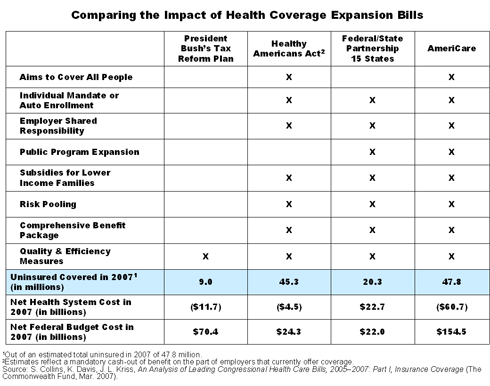Is it even remotely possible to achieve universal health coverage while also reducing overall health care expenditures? According to a Commonwealth Fund analysis of leading health reform proposals in Congress and by the Administration, it is indeed.
The report, the first in a two-part series prepared for the Commonwealth Fund Commission on a High Performance Health System, shows that several congressional bills introduced in the last two years could, if passed, significantly reduce the number of uninsured Americans and decrease health care expenditures, including those for insurance administration and prescription drugs.
The Fund's Sara R. Collins, Ph.D., Karen Davis, Ph.D., and Jennifer L. Kriss reviewed a wide range of proposals, from comprehensive reforms that would fundamentally restructure health insurance in the U.S., to more narrowly focused efforts aimed at strengthening employer-based coverage or expanding public programs. The Lewin Group, a consulting firm, estimated the impact each bill would have on stakeholder and health system costs and the projected number of people who would gain insurance coverage.

One of the most sweeping reforms is California Democrat Pete Stark's "AmeriCare" proposal, which would cover nearly all of the nation's uninsured by opening up the Medicare program to everyone, regardless of age. While AmeriCare would have a hefty price tag—$154.5 billion in federal budget outlays if fully implemented in 2007—overall health care spending would decline by $60.7 billion. That's because under the plan a lot less would be spent on insurance administrative costs (one of the advantages of public program coverage), and prescription drug prices would be lower—since Representative Stark's bill would permit Medicare to use its purchasing power to negotiate lower prices from pharmaceutical companies.
Senator Ron Wyden's (D-Ore.) Healthy Americans Act would also achieve near-universal coverage. The Wyden plan, which would help people purchase private coverage through large regional insurance exchanges, would increase federal spending by less—$24.3 billion in 2007—because of the offsetting tax revenue effects of requiring employers to "cash out" their health benefits as wages to employees. Insurance administration costs are estimated to decline by $57 billion in 2007, though the savings would be offset somewhat by the costs of administering the new program.
By contrast, President Bush's proposal to equalize the tax treatment of employer and individual coverage is estimated to cover about 9 million previously uninsured people in 2007, or one of five uninsured Americans—mostly through the individual insurance market. The Administration's plan would cost the federal government $70.4 billion in 2007 and reduce health system spending by $11.7 billion, as people would reduce their use of health services. Insurance administration costs would increase, however.
"The Institute of Medicine estimates that the poor health and shorter life spans of the uninsured cost between $65 billion and $130 billion a year," says Collins, assistant vice president for the Fund's Future of Health Insurance program and lead author of the report. "That provides a stark benchmark against which we can compare the cost of inaction versus the costs and savings of investing in a more rational and equitable system of health care in the United States."
The second report in the series, to be published by the Fund later this spring, will analyze congressional bills that seek to improve health care quality and efficiency.